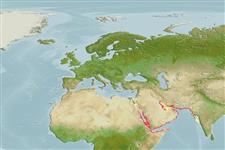>
Eupercaria/misc (Various families in series Eupercaria) >
Labridae (Wrasses) > Corinae
Etymology: Hemigymnus: Greek, hemi = half + Greek, gymnos = naked (Ref. 45335).
Environment: milieu / climate zone / depth range / distribution range
Sinh thái học
Biển Cùng sống ở rạn san hô; Mức độ sâu 1 - 20 m (Ref. 93095). Tropical
Western Indian Ocean: Red Sea, Gulf of Tadjoura, east in the Gulf of Aden at least to Sikha Island, southwest of Al Mukallah, Yemen.
Bộ gần gũi / Khối lượng (Trọng lượng) / Age
Maturity: Lm ? range ? - ? cm
Max length : 36.5 cm TL con đực/không giới tính; (Ref. 93095)
Short description
Hình thái học | Sinh trắc học
This species is distinguished by the following set of characters: gill rakers 20-23 (rarely 23); long pelvic fins, reaching anus in mature females and to or beyond origin of anal fin in males, one to spinous portion of fin; small juveniles are dark green, mottled with light yellowish green, with a white bar from anterior part of dorsal fin to abdomen, 4 faint narrower bars posteriorly, a pale bar on nape, 2 ventrally on chest; larger juveniles are dark brown with more distinct pale yellow bars; body of small females black with 5 white bars, progressively narrower posteriorly, the last posteriorly on caudal peduncle faint, the first two expanding ventrally; head white with a curving black bar from nape to eye; snout and interorbital are green with irregular pink bands radiating from eye; pectoral-fin rays yellow, membranes transparent; female in the process of sex change, indicated by the golden scale centers dorsally on the first dark bar of the body and on the dark olive bar of the nape; pelvic fins pale blue with orange streaks; body of males dark green, with spindle-shaped scales edged in light green; three pale gray bars on anterior two-thirds of body that broaden ventrally, the scale edges narrowly light green; first dark bar on body, ending at base of pectoral fin, with green margins and vertically elongate golden centers, many merging above and below, more as irregular vertical green and golden lines than as scale patterns; curving dark green bar of nape with golden scale centers, merging with a broad light yellowish brown band with irregular green bands that passes through eye onto snout; cheek with a broad near-white area, sparsely and faintly spotted with green, shading ventrally to blue; upper lip mainly greenish yellow; chest and abdomen pale blue with orange scale centers; pectoral-fin base in a large deep blue spot (Ref. 93095).
Occurs on coral reefs and adjacent habitats, on sand and coral rubble. The fish take a mouthful of sand and gravel from the substratum, where small fossorial prey are sorted out within the mouth and pharynx, and inorganic fragments are forcefully ejected from of the mouth. May also feed opportunistically on larger prey (crabs, echinoids, molluscs, ophiuroids, polychaetes) (Ref. 93095). Large breeding males in the Red Sea observed to exhibit h a reversal of the black-and-white barred color pattern of the body similar to H. fasciatus (Ref. 34222).
Life cycle and mating behavior
Chín muồi sinh dục | Sự tái sinh sản | Đẻ trứng | Các trứng | Sự sinh sản | Ấu trùng
Oviparous, with distinct pairing during breeding (Ref. 205).
Randall, J.E., 2013. Review of the Indo-Pacific labrid fish genus Hemigymnus. J. Ocean Sci. Found. 6:2-18. (Ref. 93095)
IUCN Red List Status (Ref. 130435)
Threat to humans
Harmless
Human uses
Thêm thông tin
Age/SizeSự sinh trưởngLength-weightLength-lengthLength-frequenciesSinh trắc họcHình thái họcẤu trùngSự biến động ấu trùngBổ xungSự phong phúBRUVS
Các tài liệu tham khảoNuôi trồng thủy sảnTổng quan nuôi trồng thủy sảnCác giốngDi truyềnElectrophoresesDi sảnCác bệnhChế biếnNutrientsMass conversion
Các công cụ
Special reports
Download XML
Các nguồn internet
Estimates based on models
Preferred temperature (Ref.
123201): 26.9 - 29.2, mean 28.2 °C (based on 249 cells).
Phylogenetic diversity index (Ref.
82804): PD
50 = 0.6250 [Uniqueness, from 0.5 = low to 2.0 = high].
Bayesian length-weight: a=0.00977 (0.00470 - 0.02030), b=3.07 (2.89 - 3.25), in cm total length, based on LWR estimates for this (Sub)family-body shape (Ref.
93245).
Mức dinh dưỡng (Ref.
69278): 3.5 ±0.4 se; based on size and trophs of closest relatives
Thích nghi nhanh (Ref.
120179): Trung bình, thời gian nhân đôi của chủng quần tối thiểu là 1.4 - 4.4 năm (Preliminary K or Fecundity.).
Fishing Vulnerability (Ref.
59153): Low to moderate vulnerability (27 of 100).
